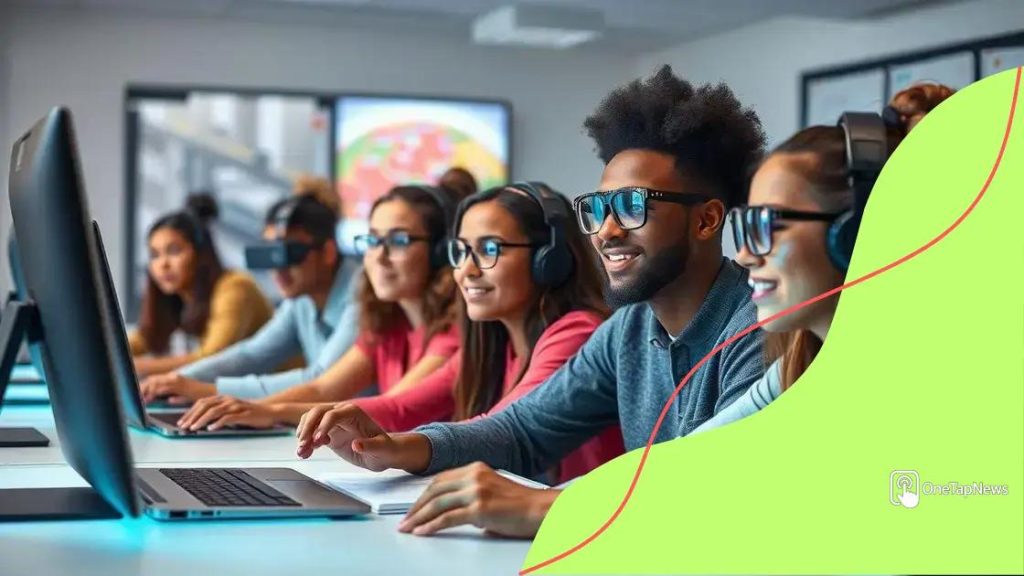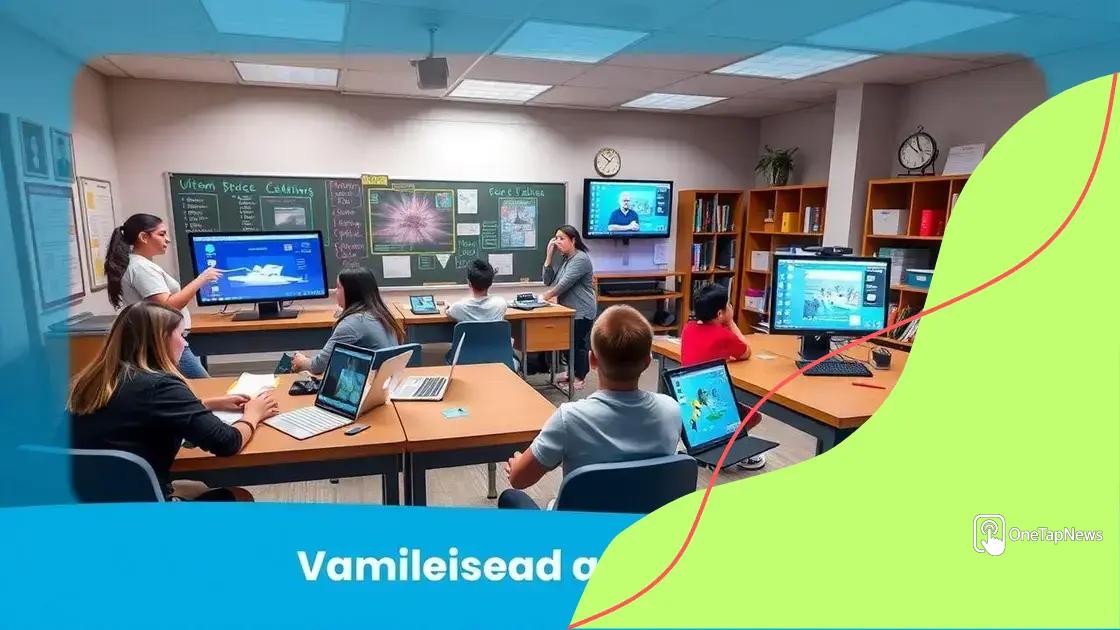The metaverse as an educational tool: Transforming learning

Anúncios
The metaverse as an educational tool enhances learning through immersive experiences, personalized instruction, and collaborative opportunities, despite challenges like cost and accessibility.
The metaverse as an educational tool is opening new avenues for learning, offering immersive experiences that can capture student interest like never before. Imagine stepping into a virtual classroom where history comes alive or science experiments happen right before your eyes. Curious about how this works? Let’s dive in.
Anúncios
Understanding the metaverse in education
Understanding the metaverse in education is crucial for leveraging its full potential. The metaverse creates a virtual space where interaction can happen in exciting ways. Imagine a classroom where students can explore different worlds and scenarios without leaving their homes.
What is the metaverse?
The metaverse is a collective virtual space that includes augmented reality, virtual reality, and the internet. It allows users to interact with each other and the environment through their avatars. This immersive experience provides numerous benefits for learners.
Benefits for Students
- Interactive Learning: Engaging students through active participation.
- Collaboration: Facilitating teamwork across distances.
- Creativity: Encouraging innovative thinking in problem-solving.
- Accessibility: Offering learning opportunities for those unable to attend traditional classes.
In the metaverse, students can simulate real-world situations. For instance, they can conduct science experiments in a virtual lab. This not only makes learning fun, but also helps in grasping complex concepts. This technology also offers the ability to join peer discussions, creating a community of learners.
Anúncios
Additionally, the metaverse supports diverse learning styles. Visual learners benefit from interactive activities, while auditory learners can engage in discussions. It allows for tailored educational experiences. By using the metaverse, educators can quickly adapt to the unique needs of each student.
Real-World Applications
Many institutions have begun exploring metaverse applications in their curricula. For example, some universities offer virtual campus tours or host lectures in a 3D environment. This not only saves time but also provides a unique experience for both students and educators. As technology continues to evolve, the possibilities within the metaverse are endless.
Ultimately, understanding the metaverse in education enables schools to innovate their teaching methods and enhance student engagement. By embracing this new technology, we can improve the way knowledge is imparted, making learning more dynamic and effective.
Benefits of immersive learning environments
Immersive learning environments provide unique advantages for students. These settings allow learners to engage with content in meaningful ways. With virtual reality and augmented reality, education becomes more interactive and exciting.
Key Benefits
One major benefit is active participation. Unlike traditional classrooms, where students often listen passively, immersive environments encourage them to take part in their learning process. By manipulating digital objects or exploring virtual spaces, they gain hands-on experience.
- Enhances Engagement: Immersion captivates learners, keeping their attention focused.
- Improves Retention: Learning experiences in 3D help students remember information better.
- Encourages Collaboration: Students can work together in virtual spaces, fostering teamwork.
- Personalized Learning: Adjust learning paths based on individual needs and preferences.
Moreover, these environments help develop critical skills. Students can practice decision-making, problem-solving, and analytical thinking. For example, a student might navigate a complex issue in a virtual simulation, applying knowledge to real-world scenarios. This not only boosts their confidence but also prepares them for future challenges.
The adaptability of immersive learning environments is another significant advantage. They can be tailored to various subjects and curricula. Whether exploring ancient civilizations or conducting science experiments, the possibilities are endless. Creative educators can leverage these resources to enhance their teaching strategies.
Facilitating Inclusion
Additionally, immersive learning can bridge gaps for diverse learners. Students with varying abilities can interact with content that suits their learning style. This inclusivity fosters a supportive atmosphere where everyone has the opportunity to excel.
In conclusion, the long-term impact of immersive learning environments is profound. They create learners who are not only knowledgeable but also equipped with essential life skills. As education continues to evolve, embracing these innovations is crucial for preparing students for a dynamic future.
How to utilize the metaverse for teaching

Utilizing the metaverse for teaching offers exciting prospects for educators. This virtual space allows for innovative teaching methods that enhance student learning experiences. With just a few strategies, teachers can create immersive lessons that engage students like never before.
Creating Virtual Classrooms
One way to utilize the metaverse is by creating virtual classrooms. These spaces mimic real classrooms but offer more flexibility. Students can explore various environments while learning concepts. For example, a virtual history class may allow students to visit ancient civilizations.
Incorporating Simulations
Teachers can also incorporate simulations into lessons. Simulations provide hands-on experiences in a safe environment. For instance, science classes can involve virtual labs where students conduct experiments without the risks of a real lab. This makes learning practical and memorable.
- Engage Different Learning Styles: The metaverse caters to visual, auditory, and kinesthetic learners.
- Foster Collaboration: Students can work together on projects from different locations.
- Real-Time Feedback: Educators can give immediate responses to student progress.
Furthermore, educators can host interactive workshops and guest lectures in the metaverse. Inviting experts to speak allows students to learn from leaders in the field. This approach gives learners a broader perspective on subjects and encourages curiosity and inquiry.
Another way to utilize the metaverse is to design gamified experiences. Gamification increases student motivation by turning learning into a game. Students can earn rewards or achievements based on their progress in a virtual platform. This not only makes learning fun but also encourages healthy competition.
Accessible Learning Opportunities
The metaverse enables accessible learning opportunities for all students. Those who may struggle in traditional settings can thrive in this environment. With flexible pacing and tailored tasks, educators can meet diverse educational needs. Embracing the metaverse can lead to enhancing inclusivity in education.
By understanding how to utilize the metaverse for teaching, educators can transform their teaching practices. This virtual realm provides endless opportunities for exploration and learning. As technology advances, so should our approach to education.
Challenges and limitations of the metaverse
While the metaverse presents exciting opportunities, it also comes with challenges and limitations. Understanding these hurdles is essential for educators and institutions looking to implement this technology effectively. One major challenge is the cost associated with creating and maintaining immersive environments.
Financial Barriers
Setting up a metaverse learning space can be expensive. Schools must invest in advanced hardware and software. Additionally, ongoing costs for content updates and maintenance can strain budgets. Educators may face difficulties in obtaining funding or resources to support these initiatives.
Technical Issues
Another limitation lies in the technical skills required to navigate the metaverse. Teachers and students may need training to use these tools effectively. Not all educators feel comfortable with technology, which can deter them from fully embracing immersive learning.
- Connectivity Issues: A stable internet connection is necessary for smooth operation.
- Device Limitations: Not all students may have access to compatible devices.
- Learning Curve: Users may require time to adapt to new platforms.
Furthermore, there are concerns regarding student engagement and motivation. Not every student benefits equally from virtual environments. Some learners may find it challenging to stay focused in a digital space, especially when distractions are present.
Additionally, there are privacy and safety concerns in the metaverse. Protecting student data and ensuring a secure online environment is crucial. There might be risks associated with data breaches or inappropriate content, which can pose serious challenges for educators.
Equity in Access
Equity also plays a significant role in the adoption of the metaverse. Students from different backgrounds may not have equal access to technology. This digital divide can lead to disparities in learning opportunities, making it difficult for all students to benefit from immersive education.
By recognizing the challenges and limitations of the metaverse, educators can strategize effectively. They can work to navigate these issues while maximizing the benefits of this innovative learning environment. Adopting a balanced approach will ensure that the potential of the metaverse is realized while addressing its drawbacks.
Future trends in educational technology
Future trends in educational technology are shaping the way students learn and interact with content. As technology continues to evolve, educators and students must adapt to these changes. One significant trend is the increased use of artificial intelligence in the classroom. AI can personalize learning experiences based on individual student needs, allowing for tailored educational paths.
Personalized Learning Experiences
With AI, students receive customized feedback and resources to help them succeed. For example, adaptive learning systems can assess a student’s understanding of a topic and adjust the difficulty level accordingly. This way, each learner can progress at their own pace, fostering a deeper understanding of the material.
Integration of Virtual Reality
Another trend is the growing popularity of virtual reality (VR) and augmented reality (AR) in education. These technologies allow students to immerse themselves in virtual environments. For instance, a history lesson could take students on a virtual tour of ancient Rome. This engages learners and makes the subject matter more relatable.
- Enhanced Engagement: Immersive experiences capture students’ attention.
- Interactive Learning: Students can participate actively in their learning.
- Safe Simulations: Students can practice skills in a risk-free environment.
Moreover, the rise of online learning platforms is another significant trend. These platforms provide students with flexible learning opportunities, enabling them to access courses from anywhere in the world. This flexibility supports lifelong learning, allowing individuals to acquire new skills and knowledge at their convenience.
In addition to these advancements, the use of data analytics is transforming educational practices. Educators can analyze student performance data to identify patterns and make informed decisions about teaching strategies. This data-driven approach helps in improving overall educational outcomes.
Focus on Collaboration
Finally, there is a growing emphasis on collaborative learning in the digital space. Online tools and platforms support teamwork and group projects, allowing students to collaborate effectively regardless of their physical location. This prepares students for the collaborative nature of modern workplaces.
As we look to the future, it’s clear that educational technology will continue to evolve. Embracing these trends is crucial for educators who want to enhance the learning experience and prepare students for a rapidly changing world.
In conclusion, the metaverse presents a wealth of opportunities and challenges in the realm of education. By embracing emerging technologies like virtual reality and artificial intelligence, educators can enhance learning experiences and create more engaging classrooms. However, it is essential to address the challenges, such as cost, accessibility, and training, to ensure equitable access for all students. As we move forward, staying adaptable and informed about future trends in educational technology will be crucial in preparing learners for success in a rapidly changing world.
\n
\n
FAQ – Frequently Asked Questions about the Metaverse in Education
What are the main benefits of using the metaverse in education?
The metaverse enhances engagement through immersive experiences, allows personalized learning, and fosters collaboration among students.
What challenges do educators face when implementing the metaverse?
Challenges include high costs, the need for technical training, ensuring student accessibility, and addressing privacy concerns.
How can virtual reality improve learning outcomes?
Virtual reality provides interactive simulations that make learning more engaging, helping students to better understand complex concepts.
What future trends can we expect in educational technology?
Future trends include increased use of artificial intelligence, more immersive virtual experiences, and a focus on collaborative online learning.